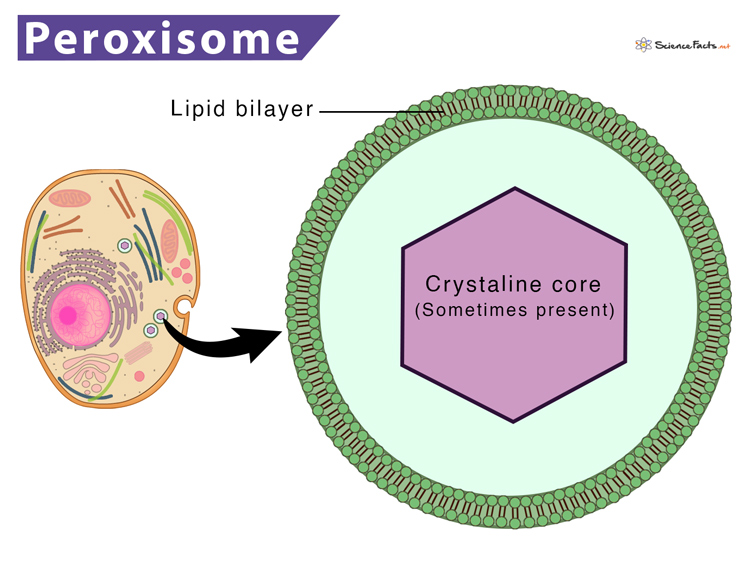In 1967, Belgian cytologist Christian de Duve discovered peroxisomes. Duve and his co-workers identified several oxidases within peroxisomes that are found to produce H2O2 and catalase that decompose H2O2 into oxygen and water. Due to their role in peroxide metabolism, Duve named them ‘peroxisomes’. They are abundant in liver cells, where lipids are stored, broken down, or synthesized.
Structure of Peroxisome
Functions of Peroxisome
However, they are generally spherical-shaped organelles averaging 0.2 to 1.5 μm in size. Peroxisomes can either exist as individual microperoxisomes or as a network of interconnected tubules called peroxisome reticulum.
Composition
It is a single, membrane-bound vesicle containing a fine, granular matrix. The membrane consists of lipids and proteins. At times, a condensed crystalline core is observed in the center of the organelle. The core contains all the enzymes necessary for its function.
How are they Formed
The assembly or biogenesis of peroxisomes is fundamentally similar to that of mitochondria and chloroplasts. Since peroxisomes lack their own DNA, proteins destined for peroxisomes are translated on free cytosolic ribosomes and then transported into peroxisomes as completed polypeptide chains. Phospholipids are also imported to peroxisomes, through phospholipid transfer proteins, from their major site of synthesis in the endoplasmic reticulum. The intake of proteins and phospholipids results in the growth of the peroxisome, and the division of existing ones then forms new peroxisomes. Any anomaly related to peroxisome biogenesis may cause peroxisome biogenesis disorders (PBD). Among all oxidations performed by peroxisomes, β–oxidation of fatty acid is most important as it provides a significant source of metabolic energy in the cell.
β–Oxidation of Fatty Acids
This pathway, mediated by peroxisomes, provides a significant source of metabolic energy in eukaryotes. In animals, fatty acids are oxidized in peroxisomes and mitochondria, but in yeasts and plants, fatty acid oxidation is restricted to peroxisomes. In β–oxidation, long chain fatty acids are progressively broken down to generate acetyl coenzyme A (acetyl CoA), releasing energy as ATP. The acetyl CoA then combines oxaloacetate to form citrate, which enters the citric acid cycle to produce more energy for the cell. The H2O2 formed is detoxified by the enzyme catalase. Some other oxidations performed by peroxisomes are the degradation of phytanic acid by alpha-oxidation and the synthesis of bile acids and plasmalogen. Some more functions of peroxisomes specific to plant and animal cells are:
Other Roles of Peroxisome in Animal Cells
It helps in lipid biosynthesis involving synthesizing long-chain fatty acids, such as cholesterol and dolichol. Bile acid also gets synthesized from the liver’s cholesterol.Synthesizing plasmalogens (family of phospholipids) are essential membrane components of heart and brain tissues.Producing bioluminescence in fireflies containing the enzyme Luciferase. It helps flies find a suitable mate for their reproduction and search for food.
Other Roles of Peroxisome in Plant Cells
Inducing germination of seeds by converting the stored fatty acids to carbohydrates that act as raw materials for germinationIt causes photorespiration in many higher plants where they take up oxygen in the light and give out some carbon dioxide, contrary to the general pattern of photosynthesis.Causing degradation (catabolism) of purines, polyamines, and amino acids by the enzyme uric acid oxidase
